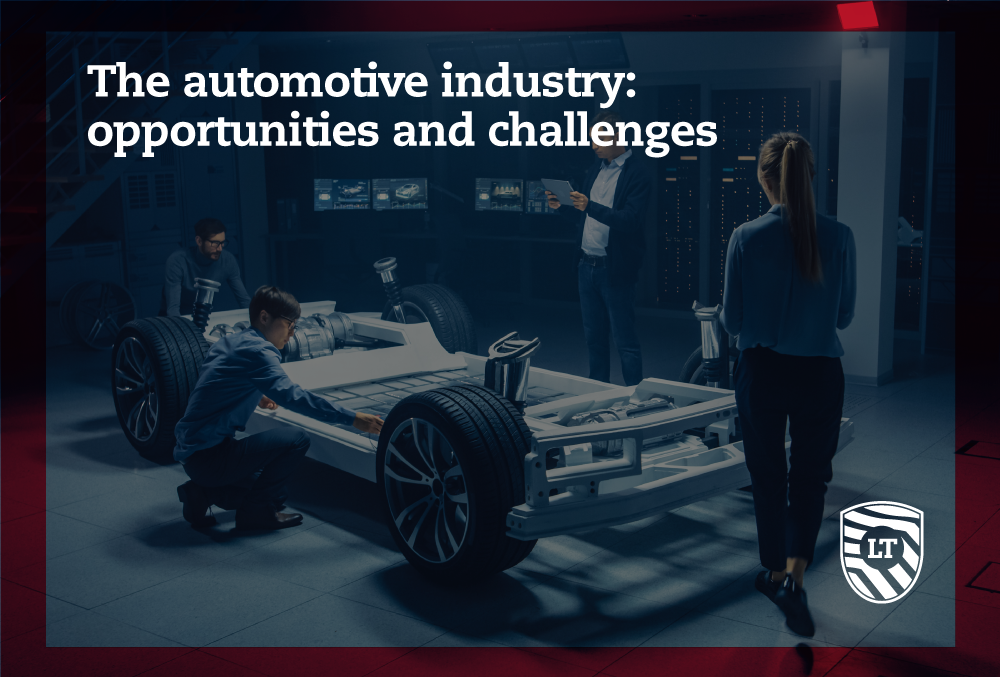The automotive industry: opportunities and challenges
Traditional manufacturers and suppliers will be very vulnerable in the coming years. They will have to fight against falling margins and at the same time invest more in electromobility and new customer-oriented innovations.
While all this process of change is being generated, the automobile industry is going through one of the most complicated moments in its history due to the combination of various factors that put the operation of companies and the flow of cars on the market at risk.
Logistics and supply problems, energy cost overruns, skilled labor problems, a complicated economic and political scenario, a more aware and demanding consumer… among others, are some of the problems that car manufacturers are facing today and in the near future.
The combustion engine that for decades has been the heart of the automobile industry is becoming obsolete. More and more new competitors will enter the market, making life difficult for the veterans, who take market positions through mergers and acquisitions.
PwC Autofacts estimates that inventory in Europe, which currently stands at more than 280 million vehicles, could be reduced to around 200 million by 2030. This would mean a decrease of more than 25%. In the case of the US, we forecast a 22% reduction to 212 million vehicles.
Due to the different market situation in China, inventory there could grow by almost 50% in the same period of time, to 275 million vehicles, despite higher utilization, but vehicle sales will continue to rise.
The automotive industry is a constant source of work, seriously threatened
The manufacture of a car involves the manufacture of a large number of elements that are joined during assembly in factories, but the automotive industry involves a whole set of organizations and companies that are dedicated to designing, developing, manufacturing and selling cars. And in all of them the human element is indispensable.
“An automobile company that employs 100 people generates effects in the hiring of up to 500 workers”, for all the associated companies that revolve around it.
Large-scale labor and economic effects
Although the vast majority of vehicles are produced in various regions of the world, pretty much of the manufacturing is concentrated in countries such as the US, Mexico, Japan, South Korea and China.
Although other smaller countries such as Slovakia, a country with just over 5.6 million inhabitants, is home to large factories for Volkswagen, Peugeot and Kia, and produces one million cars a year, making it the nation with the highest production per capita of the world.
When everyone in the car manufacturing chain is affected, the local economy suffers, especially when some production plants are closed completely or temporarily.
But the economy of the country that loses one of the main sources of exports also suffers. In Japan, a country of brands such as Toyota and Nissan, the shortage of parts caused the sector’s exports to fall 46% in September, compared to the previous year, a clear demonstration of the importance of the automotive industry for its economy.
The great dangers of the industry: lack of components, logistics and energy cost overruns
The lack of components (especially semiconductors) has been, since the industrial stoppage in China and the closure of borders caused by the pandemic and various stoppages due to weather conditions, one of the main problems for vehicle manufacturers.
AlixPartners estimates that, due to shortages, 7.7 million vehicles were put out of production this year in 2021, costing the industry $210 billion in lost revenue.
The global chip shortage forced car brands to rethink their manufacturing and distribution chain. Manufacturers have resorted to multiple contingency strategies. One of the first solutions was to reduce the number of chips needed inside a car. Since this involves reducing the capacities of the vehicles, this is naturally not considered an ideal solution.
Another temporary solution that many brands took was to continue production of vehicles and then put them aside in batches while the chips arrived. These strategies have helped, but clearly they cannot be viable long-term solutions.
But, not only electronic components are missing. Magnesium, basic for the manufacture of aluminum, and silicon are also scarce in the market with the consequent increase in prices.
The rise in the price of electricity and gas represents a significant increase in costs for a manufacturing industry such as the automotive industry.
Transportation is another of the serious problems that brands must face. Serious problems in maritime transport and a large increase in prices have generated shortages in the markets and significant cost overruns. The same has happened in road transport.
In addition, the context of economic uncertainty has generated serious problems regarding the development of automobile activity. Vehicle production is gradually moving away from its usual rhythm.
All this has caused the big brands to focus their efforts on staying afloat and, faced with this new economic scenario, they have decided to paralyze some projects and delay investments that were planned even before the arrival of the pandemic.
The pace of consolidation activity in the industry is likely to increase with new mergers and acquisitions, and this will continue as traditional providers buy technology companies to gain new products and market positions.
Uncertainty grips the automotive sector
The omens for this year are pessimistic for several reasons: lower economic growth, a lower flow of financing for the purchase of vehicles, high energy costs and, in the international context, the continued shortage of components that directly impacts the production and inventory of vehicles at dealerships, both in local and international markets.
In the last month of 2022, sales of new cars in Spain fell to 73,927 units, partly due to problems transporting cars to dealers.
In 2022, the final sales figure remains at 813,396 units, 5.3% lower than 2021 and far from the forecast of 820,000 vehicles. In addition to all of this, we must bear in mind the persistent bottlenecks in the supply of vehicles, which has greatly conditioned the activity of dealers.
There is a lack of vehicles on the market.
All of this is causing an unprecedented global car shortage, and it can take months for buyers to get their hands on the car they want.
This shortage has caused a price increase in some models of new cars and has triggered the sale and prices of used cars.
Many of the companies are only producing the vehicles that generate the highest profits, such as SUVs, pick-ups, or luxury versions.
The longer the shortage lasts, the more profound the economic effect will be. Modern economies need vehicles to function.
Trucks, essential vehicles for transporting products, are hard to find these days, which is a constraint on growth.
The decrease in sales of new cars causes a greater aging of the fleet.
In addition to affecting the economy and causing a significant drop in the volume of employment, the use of older cars causes a significant increase in the number of car accidents.
Changes in buyers
The auto industry is already seeing changes in the way buyers purchase their vehicles. The generation of young people with technical knowledge will be an important driver in the development of more sustainable and convenient mobility solutions in the coming years.
While sales or rental continue to be the primary ways to own a vehicle, there are other purchasing models that are becoming more popular, for example: subscription services, such as GM’s Maven™, Turo (owned by Daimler AG) or Getaround (owned by Toyota), or car sharing services such as Flexdrive™.
There is a considerable increase in the demand for customizations. Today, it is not enough for buyers to choose a product from a limited number of already established packages. Vehicle manufacturers can no longer be confident that they will improve high-volume production margins by minimizing the number of configurations available.
Instead, to meet this new expectation, manufacturers are building a greater variety of configurations in smaller volumes.
Buyers are also looking for vehicles that are more fuel efficient and have fewer emissions, and they’re finding that in battery electric vehicles (BEVs) or plug-in hybrid vehicles (PHEVs).
According to a report by the International Energy Agency, in 2021 almost 10% of global car sales were electric, quadruple than in 2019, reaching 16.5 million. In the first quarter of 2022 the trend continued with 2 million electric cars sold, 75% more than in 2021.
It is important to highlight the role of China in this electrified market. 3.3 million vehicles were sold in China in 2021, while 2.3 million were sold in Europe and only 630,000 in the United States. In other less developed markets, the share is negligible.
Changes in the manpower
Companies in the automotive sector need to find skilled workers to replace those who will retire in the next few years (more than 25% of manufacturing workers today are over 55), but they must also find ways to capture the institutional knowledge of retiring staff and make this information available to new staff.
And this new and mostly millennial workforce comes with its own workplace expectations, like flexible benefits and recognition of work-life balance.
Sources:
https://www.autofacil.es/industria/ventas-de-coches-nuevos-diciembre-2022/526877.html
https://www.pwc.es/es/automocion/cinco-tendencias-transformacion-mercado-automovil.html
https://www2.deloitte.com/es/es/pages/public-sector/articles/futuro-automovil-europeo.html
https://universidadeuropea.com/blog/futuro-automocion/






